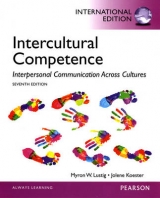
Intercultural Competence
Pearson (Verlag)
978-0-205-21124-1 (ISBN)
- Titel erscheint in neuer Auflage
- Artikel merken
Blending both the practical and theoretical, this text offers students the requisite knowledge, the appropriate motivations, and the relevant skills to function competently with culturally-different others. The text provides a discussion of important ethical and social issues relating to intercultural communication and encourages students to apply vivid examples that will prepare them to interact better in intercultural relationships.
Learning Goals
Upon completing this book, readers will be able to:
Appreciate the impact of cultural patterns on intercultural communication
Use both practical and theoretical ideas to understand intercultural communication competence
Understand some of the central contexts — in health, education, business, and tourism — in which intercultural communication occurs
Discuss cultural identity and the role of cultural biases
Dr. Myron W. (Ron) Lustig is a renowned teacher, writer, scholar, and researcher. After receiving his Ph.D. from the University of Wisconsin, he had a distinguished career as a professor of communication at San Diego State University (SDSU). He is now an emeritus professor at SDSU, a past president of the Western States Communication Association (WSCA), and a recent recipient of WSCA’s Distinguished Service Award, its highest honor. He is a former editor of Communication Reports and is currently on the editorial boards of several intercultural communication journals. His teaching and research interests include intercultural, group, and interpersonal communication theories, methods, and processes. Dr. Lustig has written 9 books or book revisions, over 30 scholarly research articles, and numerous conference papers. During several recent spring semesters, he has gained additional practical and theoretical lessons about Intercultural Competence while teaching intercultural communication to undergraduate and graduate students at Shanghai International Studies University. Dr. Jolene Koester was president of California State University, Northridge, one of the largest and most diverse campuses in the 23-campus California State University system, from 2000-2011. Under her leadership, the University improved graduation and retention rates, created a user-friendly campus, strengthened connections with the community, and increased fundraising. She also worked to make the University more learning-centered and focused on student success. Known nationally for her leadership in higher education, she currently serves on the board of directors of NAFSA, an association of international educators. She is also a past chair of the Board of Directors for the American Association of State Colleges and Universities, a former president of the Western States Communication Association, and remains active in issues related to higher education access and leadership. After earning a Ph.D. in speech communication from the University of Minnesota, she began her academic career as a professor of communication studies at California State University, Sacramento, and served in a variety of administrative positions there, including provost and vice president for academic affairs, prior to her appointment as president of Cal State Northridge.
In this Section:
1) Brief Table of Contents
2) Full Table of Contents
1) Brief Table of Contents
Part 1: Communication and Intercultural Competence
Chapter 1: Introduction to Intercultural Competence
Chapter 2: Culture and Intercultural Communication
Chapter 3: Intercultural Communication Competence
Part 2: Cultural Differences in Communication
Chapter 4: Cultural Patterns and Communication: Foundations
Chapter 5: Cultural Patterns and Communication: Taxonomies
Chapter 6: Cultural Identity and Cultural Biases
Part 3: Coding Intercultural Communication
Chapter 7: Verbal Intercultural Communication
Chapter 8: Nonverbal Intercultural Communication
Chapter 9: The Effects of Code Usage in Intercultural Communication
Part 4: Communication In Intercultural Relationships
Chapter 10: Intercultural Competence in Interpersonal Relationships
Chapter 11: Episodes, Contexts, and Intercultural Interactions
Chapter 12: The Potential for Intercultural Competence
2) Full Table of Contents
Part 1: Communication and Intercultural Competence
Chapter 1: Introduction to Intercultural Competence
Imperatives for Intercultural Competence
Communication
The Challenge of Communicating in an Intercultural World
Chapter 2: Culture and Intercultural Communication
Culture
Why Cultures Differ
Intercultural Communication.
Chapter 3: Intercultural Communication Competence
The United States as an Intercultural Community
Competence and Intercultural Communication
Basic Tools for Improving Intercultural Competence
Part 2: Cultural Differences in Communication
Chapter 4: Cultural Patterns and Communication: Foundations
Defining Cultural Patterns
Components of Cultural Patterns
Characteristics of Cultural Patterns
Cultural Patterns and Intercultural Competence
Chapter 5: Cultural Patterns and Communication: Taxonomies
Hall’s High- and Low-Context Cultural Taxonomies
Hofstede’s Cultural Taxonomies
The GLOBE Cultural Taxonomy
A Synthesis of Cultural Taxonomies
Chapter 6: Cultural Identity and Cultural Biases
Cultural Identity
Cultural Biases
Identity, Biases, and Intercultural Competence
Part 3: Coding Intercultural Communication
Chapter 7: Verbal Intercultural Communication.
The Power of Language in Intercultural Communication
Definition of Verbal Codes
Language, Thought, Culture, and Intercultural Communication
Verbal Codes and Intercultural Competence
Chapter 8: Nonverbal Intercultural Communication
Characteristics of Nonverbal Codes
Cultural Universals in Nonverbal Communication
Nonverbal Functions in Intercultural Communication
Cultural Variations in Nonverbal Communication
Nonverbal Messages in Intercultural Communication
Synchrony of Nonverbal Communication Codes
Nonverbal Communication and Intercultural Competence
Chapter 9: The Effects of Code Usage in Intercultural Communication
Preferences in the Organization of Verbal Codes
Cultural Variations in Persuasion
Cultural Variations in the Structure of Conversations
Effects of Code Usage on Intercultural Competence
Part 4: Communication In Intercultural Relationships
Chapter 10: Intercultural Competence in Interpersonal Relationships
Cultural Variations in Interpersonal Relationships
The Maintenance of Face in Interpersonal Relationships
Improving Intercultural Relationships
Interpersonal Relationships and Intercultural Competence
Chapter 11: Episodes, Contexts, and Intercultural Interactions
Social Episodes in Intercultural Relationships
Contexts for Intercultural Communication
Episodes, Contexts, and Intercultural Competence
Chapter 12: The Potential for Intercultural Competence
Intercultural Contact
The Ethics of Intercultural Competence
The Perils and Prospects for Intercultural Competence
Resources
Intercultural Films
Online Resources
Notes
Credits
Author Index
Subject Index
| Erscheint lt. Verlag | 28.8.2012 |
|---|---|
| Sprache | englisch |
| Maße | 188 x 231 mm |
| Gewicht | 560 g |
| Themenwelt | Kunst / Musik / Theater ► Theater / Ballett |
| Sozialwissenschaften ► Kommunikation / Medien ► Kommunikationswissenschaft | |
| ISBN-10 | 0-205-21124-0 / 0205211240 |
| ISBN-13 | 978-0-205-21124-1 / 9780205211241 |
| Zustand | Neuware |
| Haben Sie eine Frage zum Produkt? |
aus dem Bereich



